NJFSC Chapter #44S..........PHS Affiliate #1A..........APS Affiliate #95 |
Society & Member's Galleries....
As we continue to add more galleries, some will be for public display while many will be reserved for members access only.
Featured Covers Gallery
November 2014 Issue of the NJPH Journal N.J. LOCAL POSTS: Bayonne City Dispatch
By Larry Lyons
This is the third of a series of articles on New Jersey’s local stamps. Local Posts were established as
early as the 1840’s by enterprising private individuals and companies who carried letters within city
limits – including to and from Post Offices. They flourished for a number of years until they were
finally outlawed by the government. The author, Larry Lyons, is a noted authority on United States
local stamps, and is the editor-in-chief of “The Penny Post,” the prize winning journal of The
Carriers and Locals Society. We appreciate his contributions.
Two fairly modern comprehensive articles have previously been written on this subject in
1989 and 2002. The first was by Robert G. Kaufmann1 and the second was written by John D.
Bowman.2 The content of those articles are summarized in this article. This article will expand on
the preceding articles with information gathered from a detailed census undertaken by this author.
HISTORY
The Bayonne City Dispatch was a short-lived local post which was allowed to briefly function
due to a lack of carrier service at four government post offices located in Bayonne, Van Buskirk,
Saltersville and Bergen Point. Bayonne City Dispatch Mail is only recorded from May 9, 1883 to
May 19, 1883 and on June 14, 1883. An example of the adhesive stamp is shown in Figure 1.

In Kaufmann’s article we learn that the delivery of mail from one town to another was
often done by sending the mail to New York for sorting and then back again to the town post
office. Therefore it often took four or five days for a letter to be delivered even though the
distance was less than one mile. You could also add a day or two for carrier delivery since very
few carriers were employed. At the Bergen Point Post Office, for instance, a Richard Denver
was the only carrier. Local merchants were not pleased with the situation since most of their
business was announced by circulars sent through the mails. Local residents in many cases had
to wait a week for mail delivery and news from only a mile away. There was undoubtedly some
outrage over this condition and it gave rise to the creation of a local post called the Bayonne City
Dispatch. Roswald Edward Smith was the proprietor of the post and he visited Boyd’s and
Hussey, the large local posts in New York, for ideas on his organizing the local post in Bayonne.
The short-lived, illegal upstart local posts of the 1880s were as much about providing a service and an attempt at some profit as about showing the government post office their shortcomings
and the need for better service. Roswald Smith had to know that his activity would be quickly
suppressed. The census record indicates operation over a ten-day period in May 1883 and on
one day in June. Figure 2 shows an example of a Bayonne City Dispatch cover. |

|
If no government carrier service was available in Bayonne in 1883, Roswald Smith may
have considered his operation to be legal. If no carrier service was available in a town, it
appeared that a loophole in the postal laws and regulations existed. Without carrier service from
the U.S. Post Office, a city’s roads and streets might not be regarded as “postal routes” and
therefore private companies might be able to deliver mail to and from the post office.3
BAYONNE CITY DISPATCH
This local post was announced in a company circular dated April 10, 1883 and an
announcement in the Bayonne Times of April 5, 1883. No recorded covers of this post exist
before May 9, 1883, a day on which operation may have commenced. The advertised table of
postage rates for letters was as follows:
| |
South of 28th St. 1 cent. |
| |
South of 38th St. 2 cents. |
| |
East of Avenue F 3 cents. |
| |
South of Division St. 2 cents. |
| |
North of Division St. 3 cents. |
There was also a rate card which differed from the above with the following first two lines:
| |
South of Twentieth Street 1 cent. |
| |
South of Thirtieth Street 2 cents. |
The research indicates there is only one surviving cover with two one-cent stamps. This
example is a wrapper to Chas. M. Packard, 28th Street, Hook, dated May 10, 1883. (See Figure 3.)
The area south of 30th Street was known was Van Buskirk and was nicknamed “Hook.” It would
become Constable’s Hook in 1887. It seems the rate card was applied and the rate for this letter
was 2 cents. No covers with a three cent rate are recorded. This one cover with more than the
one cent rate is a horizontal pair and is the only recorded pair of stamps.

ISSUES OF THE BAYONNE CITY DISPATCH
The stamp was printed in black ink on white paper and was typeset with an image of a
horse-drawn stagecoach. An 1885 article states the stamps were printed in a sheet of ten. John
Bowman discovered two double transfer varieties. The doubling occurs most prominently in the
ornament below the stagecoach and the horizontal line to the left below the stagecoach. Most
used stamps are cancelled with a purple three-ring concentric killer in which the thickness of
each ring increases with distance from the center. There are two types of three-line typeset
handstamps. One reads “Dispatch” at the bottom and the second reads “Dispatch PAID”. (See
Figure 4.)

There is a stationery item, 9LU1 entire which is handstamped with the stamp image at the
upper right in blue. The Scott Catalogue calls the ink color purple. (See Figure 5.)

Two unused examples of the postal stationery are recorded and one used example is
recorded addressed to Geo. Thomas, Esq., Avenue D. Bergen Point. (See Figure 6.)

PHILATELICALLY IMPORTANT HISTORICAL FACTS
The Bayonne City Dispatch was organized to send messengers to call at residences and
business houses of regular customers three times a day. The main office was on 16th Street near
Avenue D with most of the business of the post being done with the Bergen Point Post Office.
Mail boxes were placed in the LaTourette Hotel and other hotels. Many recorded covers are
addressed to LaTourette at 16th Street which most probably was for his pick-up at the local
dispatch office, or were forwarded to him. LaTourette’s Hotel was owned by the family of
Philip LaTourette and was located on the Kill von Kull at the southern end of Bergen Point. The
hotel was a resort for New York and New Jersey society folk. The hotel was heavily damaged by
fire in May 1916.
According to Elliot Perry, LaTourette and stamp dealer Dr. William Mitchell were
friends. LaTourette authored many articles in Mitchell’s journal and also advertised buying and
selling of local posts. Two of the recorded covers are addresses to Wm. Mitchell. Harry Craft
was also a friend of Dr. Mitchell and four of the Bayonne City Dispatch covers are addressed to
him. The covers addressed to Philip LaTourette were written in many different hands and did
not stem from the same source. I surmise from this that they were of a business nature. Some
covers are addressed to Philip LaTourette, Jr. and some to Philip LaTourette, Esq.
Five of the recorded Bayonne City Dispatch covers were taken to the post office and
entered the mails. About 17 different addressees are recorded on Bayonne City Dispatch covers. These observations strongly suggest that the post had a legitimate existence.
THE LYONS CENSUS
Knowing that many covers would be found addressed to the same individual it was
necessary to take additional steps beyond the recording of the dates and addresses when taking
the census. Over a two-day period of time 275 auction results were reviewed and next to each
line I recorded a sketch of the angle of the Bayonne City Dispatch stamp on the cover with the
location of the 3-ring handstamp on to the stamp. If the cover was addressed to LaTourette the
letters of the addressees name in relation to the stamp was also recorded. In this manner
duplication could be weeded out and new sightings could be definitely confirmed. I recorded 43
different covers. I recorded the period of use as follows:
| May 9, 1883 |
4 examples |
| May 10, 1883 |
3 examples |
| May 12, 1883 |
4 examples |
| May 13, 1883 |
5 examples |
| May 14, 1883 |
3 examples |
| May 15, 1883 |
13 examples |
| May 16, 1883 |
4 examples |
| May 19, 1883 |
4 examples |
| June 14, 1883 |
3 examples |
From the above I concluded the EKU to be May 9, 1883. The covers span a period of
about 10 days. We then have a gap of 25 days followed by three covers taken to the post office
on June 14, 1883. It seems this was just a clean-up day for Roswald Smith. Undoubtedly the
Bayonne City Dispatch was shut down on May 19, 1883 and no local deliveries were made after
that date. It is assumed the government took action and hopefully heard the customer
dissatisfaction and rectified the situation by hiring more carriers. This would legally make the
post roads and streets off limits to the Bayonne City Dispatch and would force their closure.
CONCLUSION
The research and census exercise provided some additional information on the Bayonne
City Dispatch. I am in agreement with John Bowman who concluded in his article that the
examples of this post are probably legitimate. The covers are highly collectible and the average
collector would be fortunate to have an off-cover example of the adhesive and an example on
cover. An off-cover used example has a catalogue value of $275.00 and a locally delivered
cover has a value $750.00. Special examples taken to the post office with U.S. stamps paying
the postage are in the $1,500-$3,000 range. (See Figure 7.) The only recorded pair on cover
previously sold in the Dick Schwartz sale of Robert Siegel, in June 2000, and reappeared in a
Shreve sale of June 2002, Lot 914 where it realized $2000. 9LU1 unused is seriously
underpriced in the catalogue at $175. There are only two recorded examples.

John Bowman received information, inspiration, and feedback from postal historian Calvet
Hahn for his 2002 article. For more information on this subject the reader should read the Bowman
article.
______________________________________________
ENDNOTES:
1 Kaufman, Robert G., “Bayonne City Dispatch Company,” Postal History Journal, No. 82, June 1989, page 48.
2 Bowman, John D., “Bayonne City Dispatch,” The Penny Post, Vol. 10, No. 4, October 2002, pages 27-36.
3 Ibid, page 34.

|
Past Featured Covers
 |
August 2014 Issue of the NJPH Journal AN EARLY BURLINGTON POSTMARKED COVER
By Ed & Jean Siskin
Burlington, New Jersey was founded by two Quaker groups in 1677, five years earlier
than Philadelphia. It was a planned community and the original draft map of the town prepared in 1678, contains many of the same street names that exist today.
Read more..... |
 |
May 2014 Issue of the NJPH Journal NEW JERSEY’S NEGATIVE LETTERED STAMPLESS POSTMARKS by
Robert G. Rose
During the period that domestic stampless mail was permitted ending in 1855, two New Jersey post offices employed negative lettered handstamped postmarks. As a branch of postal
history known as “marcophily,” these markings are avidly collected for their eye-catching
appearance.. Read more..... |
 |
February 2014 Issue of the NJPH Journal BRIDGETON FORERUNNER, 1694 By Ed & Jean Siskin
The excellent articles on the Bridgeton Post Office and its postmasters by Doug D’Avino
started with its first United States post office in 1792. As a prequel to those articles, it is worth
discussing a letter from the Bridgeton area a century earlier. Read more..... |
 |
November 2013 Issue of the NJPH Journal JERSEY CITY AND THE BEGINNING OF BIG TOBACCO By John A. Trosky
P. Lorillard & Company, one of the most iconic names in the tobacco industry in
America, had its beginnings in the New York City area in the mid 17th century. The company
was founded by Pierre Abraham Lorillard, a French Huguenot, in the year 1760. Its small
beginnings Read more..... |
 |
August 2013 Issue of the NJPH Journal UNOFFICIAL REGISTRATION OF NEW JERSEY STAMPLESS COVERS By James W. Milgram, M.D.
From November 1, 1845 to June 30, 1855 there was an unofficial type of Registration of
valuable letters at most post offices within the United States. The first marking is the large blue
“R” applied on receipt at Philadelphia beginning in 1845 Read more.....
|
 |
May 2013 Issue of the NJPH JournalSTAGE OPERATIONS AND THE MAILS IN NEW JERSEY©
By Steven M. Roth (© 2013. Steven M. Roth)
Prior to the Revolutionary War, major travel in the American colonies was restricted
for the most part to the Read more..... |
 |
February 2013 Issue of the NJPH Journal INTENDED FOR THE GRAF ZEPPELIN BUT CARRIED BY STEAMER? A 1929 Jersey City Transatlantic Airmail to Basel Switzerland
by John Trosky
The first decades of the 20th century saw the dawn of a new age in mail transport, airmail. By
the late 1920s Read more..... |
 |
November 2012 Issue of the NJPH Journal LEGISLATIVE FRANKS OF NEW JERSEY by Ed & Jean Siskin
The franking privilege is the right to send and or receive mail free from postage.
Read more..... |
 |
August 2012 Issue of the NJPH Journal HADLEY AIR FIELD, NEW BRUNSWICK. NEW JERSEY by Jim Walker
Early air mail service in the New York area used an assortment of air fields on Long
Island. Hazlehurst Field was the one in use at the commencement of Transcontinental Air Mail
Service in 1924 and was deemed inadequate due to smoke from city industries and ocean fog.
Read more..... |
 |
May 2012 Issue of the NJPH Journal FIVE CENT 1856 STAMP ON COVERS FROM NEW JERSEY by Robert G. Rose
Have you ever fantasized, as have I, of forming a collection of United States
classic stamps used on covers from New Jersey? If so, the task to put such a collection
together would be a real challenge....
Read more..... |
 |
February 2012 Issue of the NJPH Journal A Wonderful Revolutionary Letter by Ed and Jean Sisken
In the Oct-Nov 1988 issue of La Posta, Tom Clarke wrote an article about a wonderful
Revolutionary War cover he had. Dated February 16, 1777, from New Brunswick, New Jersey...
Read more..... |
 |
November 2011 Issue of the NJPH Journal New Jersey Civil War Covers -Wyman the Wizard!
If you were to conduct a detailed review of the 190 Civil War
patriotic covers illustrated in NJPH whole nos. issues 100 and 117, or the
online exhibit of covers shown at NOJEX, you can begin to see the
emergence of some interesting patterns among the covers. An obvious
pattern is that there are several different correspondences represented in
the illustrated covers. Read more..... |
 |
August 2011 Issue of the NJPH Journal New Elizabeth, NJ Marking
ELIZABETHTOWN STAMPLESS POSTMARK ALTERED TO READ “ELIZABETH”!
This newly-discovered Elizabeth postmark falls at the time the name was changed from
Elizabethtown to Elizabeth, and a new handstamp was created from an existing Elizabeth-town
postmark.
Read more..... |
 |
May 2011 Issue of the NJPH Journal Civil War Patriotic Covers from New Jersey.
The cover below is dated Mar. 10 from Bloomsbury, NJ to West Liberty, Ohio, with the imprint of S.C. Rickards, Stationers, 102 Nassau Street, N.Y., and shows one of the rare New Jersey Civil War patriotic images.
Read more..... |
 |
February 2011 Issue of the NJPH Journal A Folded Letter in art - was it from New Jersey?
This painting by Jacques-Louis David, painted in 1821, shows two Bonaparte princesses reading a stampless folded letter from their father, Joseph Bonaparte, brother of Napoleon. Was it written to them from New Jersey?
Read more..... |
 |
November 2010 Issue of the NJPH Journal REVOLUTIONARY WAR COVER
The cover of our most recent journal features this Revolutionary item, from Don Chafetz’s prize-winning exhibit of Morris County Mail Service, 1760 to 1850.
Read more..... |
 |
August 2010 Issue of the NJPH Journal NEW JERSEY ILLUSTRATED LETTER SHEETS
These items were made popular by the nice ones that exist from the California Gold Rush days, and those used during the Civil War, where they depicted contemporary scenes at the top of the letter sheet, the rest of which was then used to write a letter.
Earliest examples usually included an attached sheet and were used as stampless folded letters.
Later ones were more like letterheads, and were sent enclosed in envelopes.
Read more..... |
 |
May 2010 Issue of the NJPH Journal Celebrates the 100th Anniversary of the Boy Scouts of America!
Treasure Island Scout Camp occupies a fifty-seven acre island in the Delaware River between Pennsylvania and New Jersey. The camp is operated by the Cradle of Liberty Council (formerly the Philadelphia Council), Boy Scouts of America. Read more..... |
 |
February 2010 Issue of the NJPH Journal featuring a 1995 cover of the aircraft carrier USS Kitty Hawk, the last of the conventionally-powered US aircraft carriers, decommissioned in 2009.
This great ship served almost 50 years in service of her country.
Read more..... |
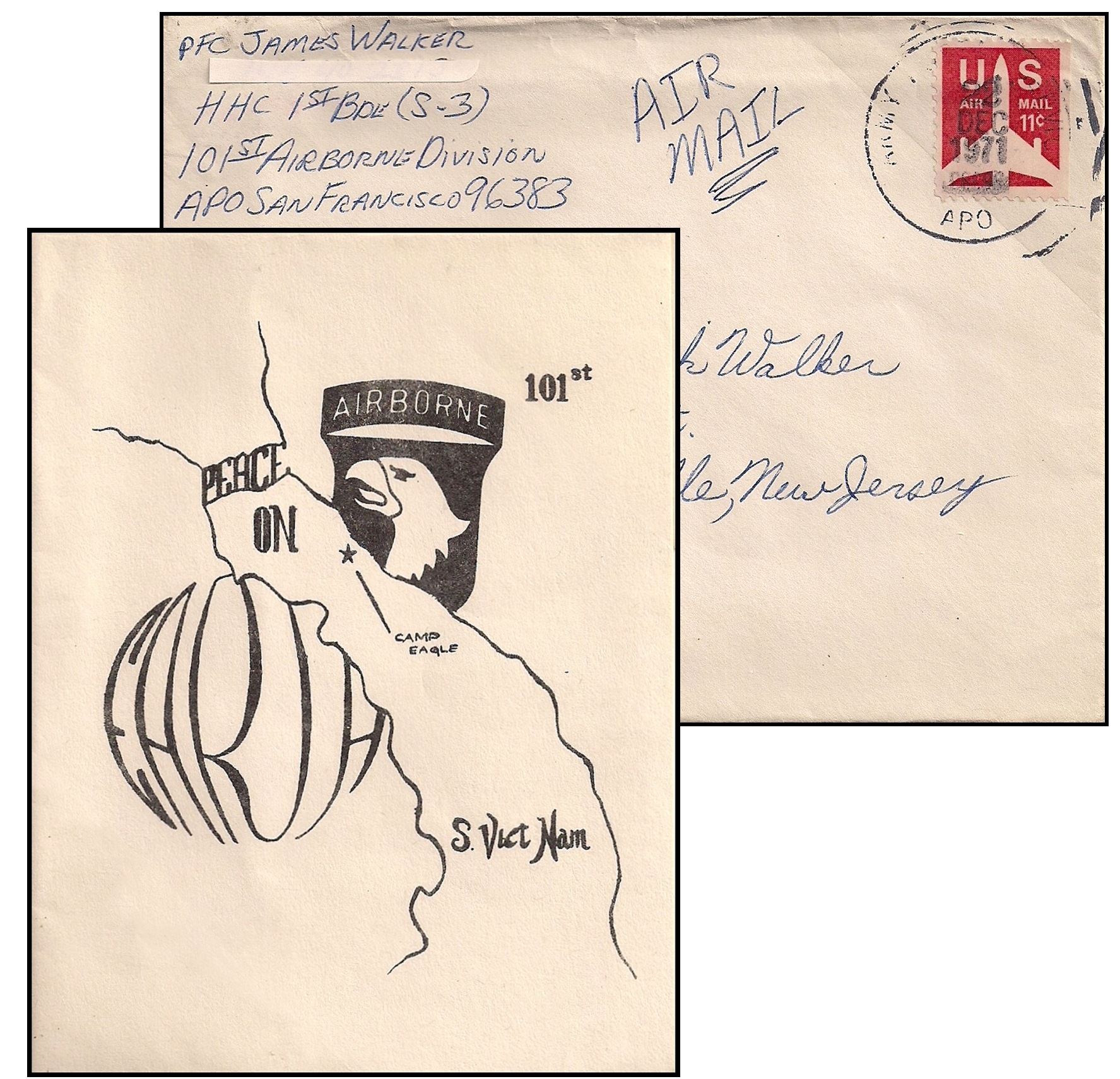 |
November 2009 Issue of the NJPH Journal featuring a Holiday Greetings from Viet Nam
Just before Christmas of 1971, a GI-produced Christmas card was distributed to the troops of the 101st Airborne for them to send home. A hand-made envelope served to carry it home to New Jersey.
As it was late in December, member Jim Walker used a U.S. air mail stamp instead of the usual free frank available to soldiers in combat,
Read more..... |
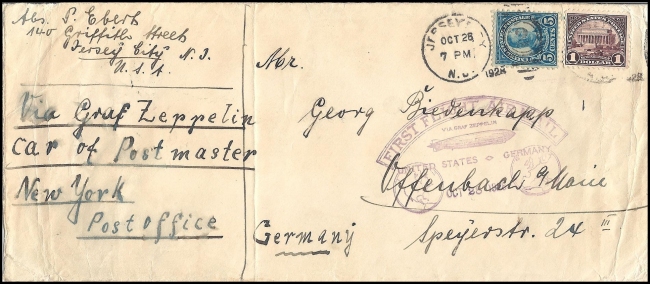 |
August 2009 Issue of the NJPH Journal featuring a a Graf Zeppelin cover.
L127 First Trip to the USA in 1928. Special credit to John Trosky for this nice article!
WEB-SITE SPECIAL: an addendum to this article with additional information on an originating 1928 LZ-127 cover from Len Peck!
Read more..... |
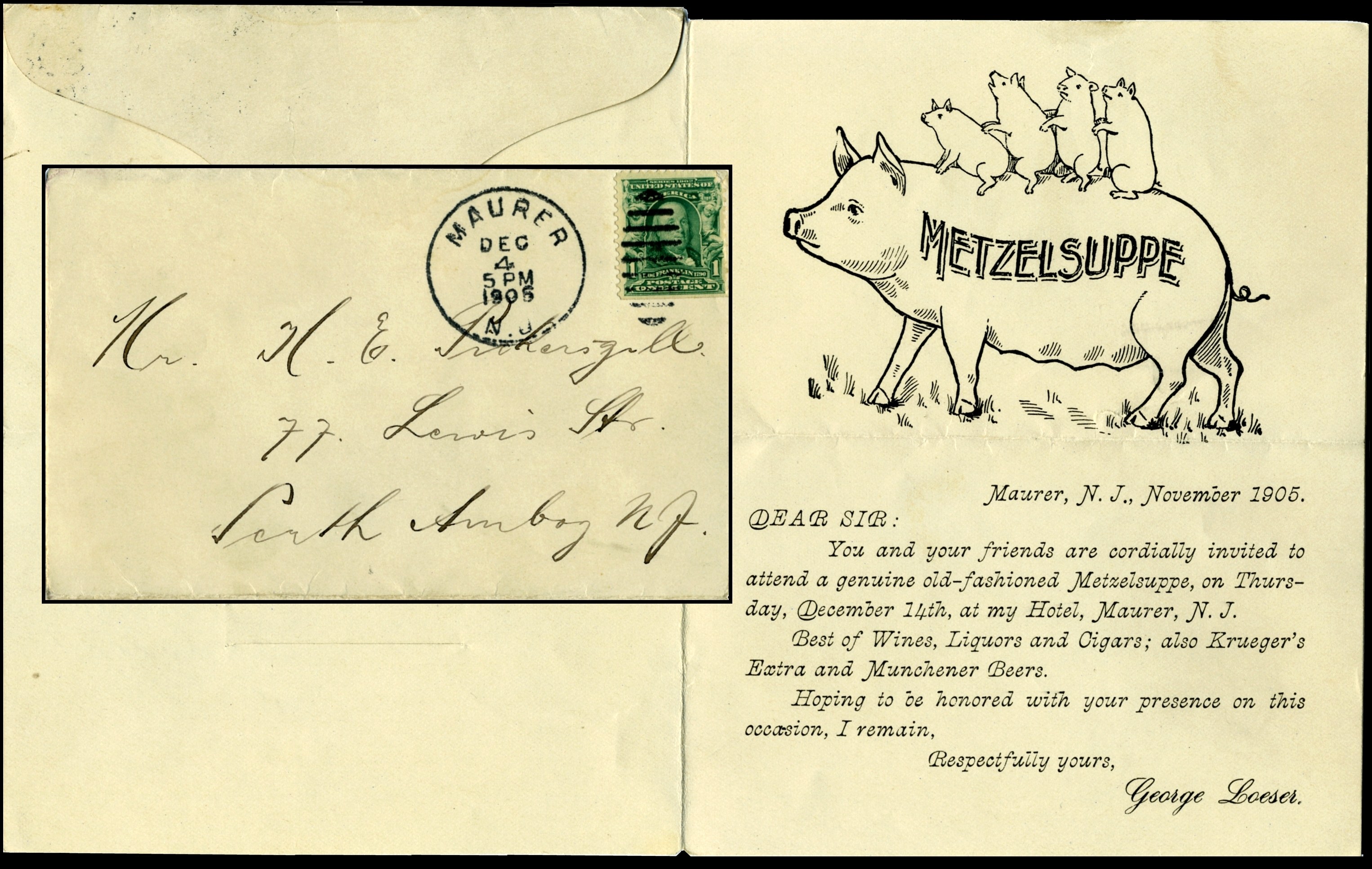 |
May 2009 Issue of the NJPH Journal featuring a DPO cover from Maurer, New Jersey.
A pretty little letter sheet invitation from a local hotel in Maurer (now part of Perth Amboy, Middlesex County), NJ turned up at the Garfield-Perry Show in Cleveland, in JWF (Jim Faber’s) stock. Used in 1905, it is from a community that literally does not exist anymore. The location is now the site of a large “tank farm” belonging to Chevron.Read more..... |
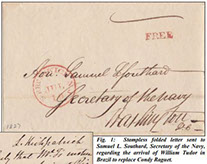 |
February 2009 Issue of the NJPH Journal featuring a cameo campaign cover.
A December 15, Hoboken, NJ postmarked Embossed Cameo Campaign Envelope produced by William Eaves was offered this March by Robert A. Siegel Auctions featuring a beardless Abe Lincoln. Only a few examples are known. This Hoboken, New Jersey cover hammered on March 25, 2009 for $2600.00 before the 15% buyers premium! Read more..... |
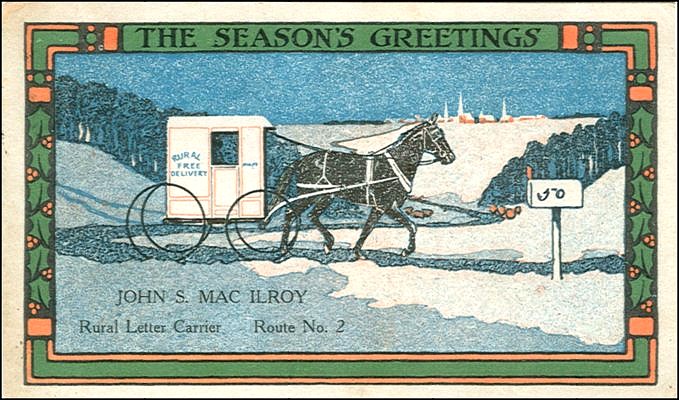 |
November 2008 Issue of the NJPH Journal featuring a cover of seasonal greeting.
A RFD ”Season’s Greetings” post card, cancelled December 24, 1915 with a Pittstown, NJ postmark, sent by the carrier on Route 2 out of Pittstown to the people along his route. Special thanks to Member Jim Walker for sharing this cover. Read more..... |
Members: One of the benefits of membership is sharing your interests and collections! If you would like to share an interesting single item from your collection, or have multiple items to share - the NJPHS Galleries offer you the opportunity to put your collectibles on center stage. Please e-mail your webmaster about contributing to our on-line Galleries. We can even help you if you do not have a scanner or digital images. Just ask. Remember, we are always looking for articles of interest for the NJPH Journal, and would welcome your contribution whether it's a single page or five page article.
If you are not yet a member, please consider the benefits of joining and the satisfaction you'll get by sharing with your fellow collectors: Become a Member |
